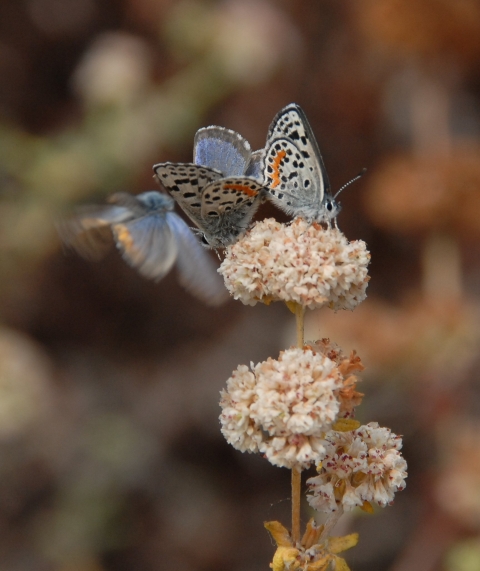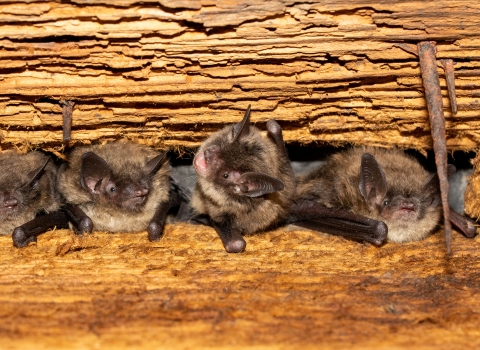Carolyn Lieberman has the ocean in her veins. She grew up on the East Coast and fondly remembers spending summers at the beach with her family. As an adult, she moved to San Diego to study seagrass and surf every day.
Now as the Coastal Program Coordinator for the Carlsbad Fish and Wildlife Office, she spends her days restoring native coastal ecosystems and conserving their inhabitants with partners who share her passion.
Lieberman’s work helps recover endangered species like the El Segundo blue butterfly (Euphilotes battoides allyni), a thumbnail-sized butterfly found only in Los Angeles County from the Ballona Wetlands south to the Palos Verdes Peninsula.
A few years ago, Lieberman was contacted by Ann Dalkey – marine biologist, avid reader and Redondo Beach resident – about invasive ice plant growing on the Esplanade bluffs at Redondo Beach. Dalkey knew the area was one of four places designated by the U.S. Fish and Wildlife Service for expanding the El Segundo blue population, and she also knew the non-native South African plant didn’t provide much wildlife habitat.
Lieberman and Dalkey formulated a plan to replace it with native vegetation such as seacliff buckwheat, beach suncup, and beach sand verbena, food sources for the butterfly and many other species.
“The El Segundo blue is a pollinator, and pollinators are extremely important because one in every three bites of food we eat comes from something that’s pollinated,” said Lieberman. “So if we’re doing work to benefit the El Segundo blue, we’re going to be helping other pollinators, and then the things that eat them. We’re recreating an ecosystem that’s better for all the other animals, and ultimately us,” she said.
Lieberman secured $252,600 in funding but needed manpower for the project. The two then partnered with the Los Angeles Conservation Corps (LACC) which employs at-risk 18-25 year olds in order to connect inner-city youth with meaningful restoration work.
Jonathan Alvarado didn’t think he’d necessarily like the work of LACC when he joined the program as a Corps member. He handled recycling, city beautification, and graffiti removal projects for about a year before getting promoted to a driver position. He was then promoted to maintenance worker, and ultimately to his current position as crew supervisor of new Corps members.
The more time I spent, the more I liked these type of jobs,” said Alvarado. “Not only do I have the chance to help out the community and environment, but I also get a good feeling from helping out other Corps members – having a place where they can come, learn something, get along with each other, and be provided with assistance.”
LACC is a holistic program with three prongs – members gain work experience; a partnering high school helps with attaining their diploma; and a case management team assists with childcare, housing, substance abuse and legal issues.
“We’re a second chance program,” said Robert Skillman, LACC Director of Conservation Programs. “We have Site Directors, managers, project coordinators and field staff who were Corps members, so it’s a huge promotion opportunity from within. Even if LACC members don’t remain working in the field after the program, they do get into backpacking, hiking, going to the beach, and volunteering for projects like this.”
“This project exposes Corps members to a piece of land that belongs to them as well. Some of our members have never seen the beach before; even though they’re 15-20 miles inland, they just never had access to the beach,” he said.
The Service and LACC recently connected with the South Bay Parkland Conservancy (SBPC) to enlist more help through volunteers. SBPC partners with residents, government agencies, and conservation organizations to create and preserve parks in the South Bay’s coastal cities.
Jim Montgomery joined SBPC’s board in February and is the restoration project leader. He also works at NASA’s Jet Propulsion Laboratory, bringing a unique perspective on life’s biodiversity to the organization.
“I’m grateful to be involved,” said Montgomery. “It’s a beautiful community effort with we humans being good relatives with the rest of the planet. By planting different plants we’re providing habitat for different critters. Let’s establish greater diversity in plant life and see what other critters come and help rebuild that web of life.”
Community involvement creates a sense of ownership of the land, providing residents with an opportunity to give back to their neighborhoods while decreasing the chances of damage to it.
“Jim’s enthusiasm is contagious,” said Lieberman. “I’m so excited he has this vision, and that the community is starting to rally around this project. Having the community involved is going to make it synergized and go so much further.”
Recent surveys have already observed hundreds of blue butterflies during flight season, and the partners will continue their work over the next five years to restore 6.9 acres of habitat.





